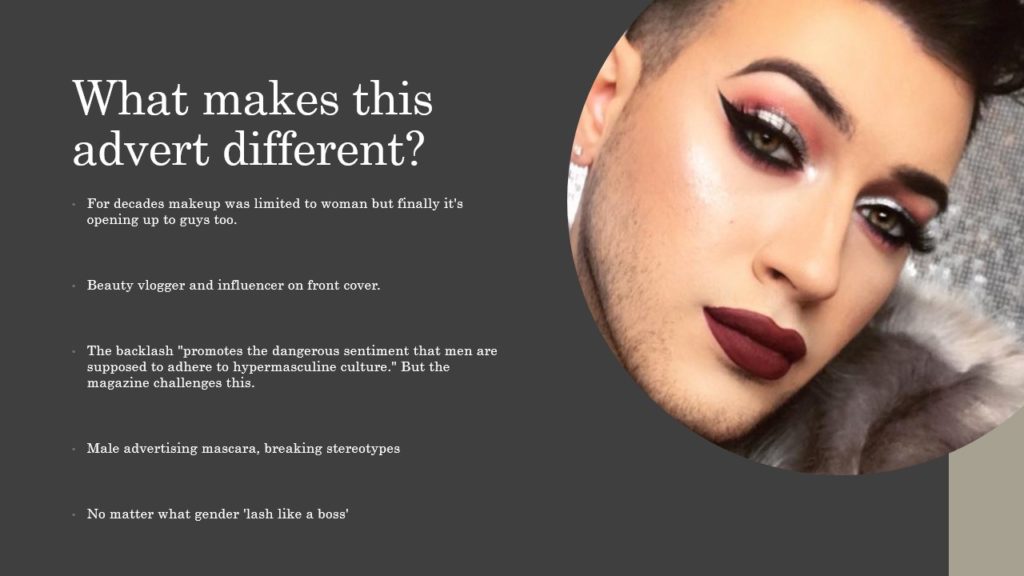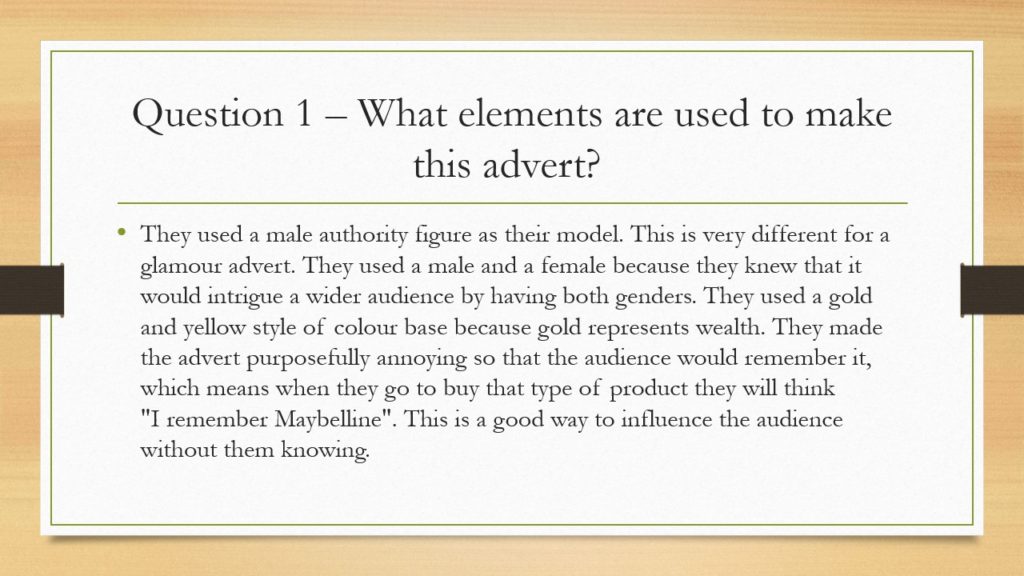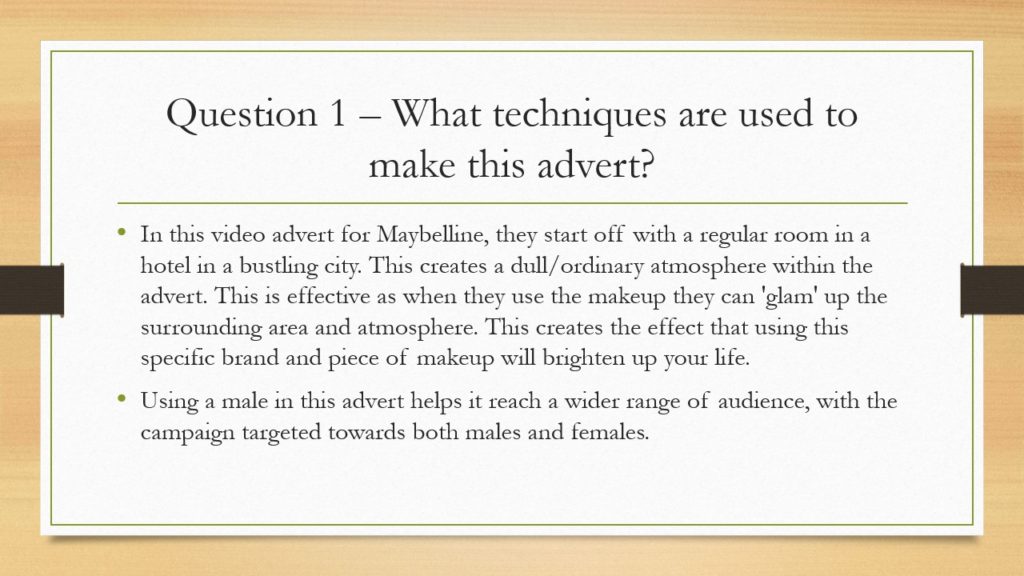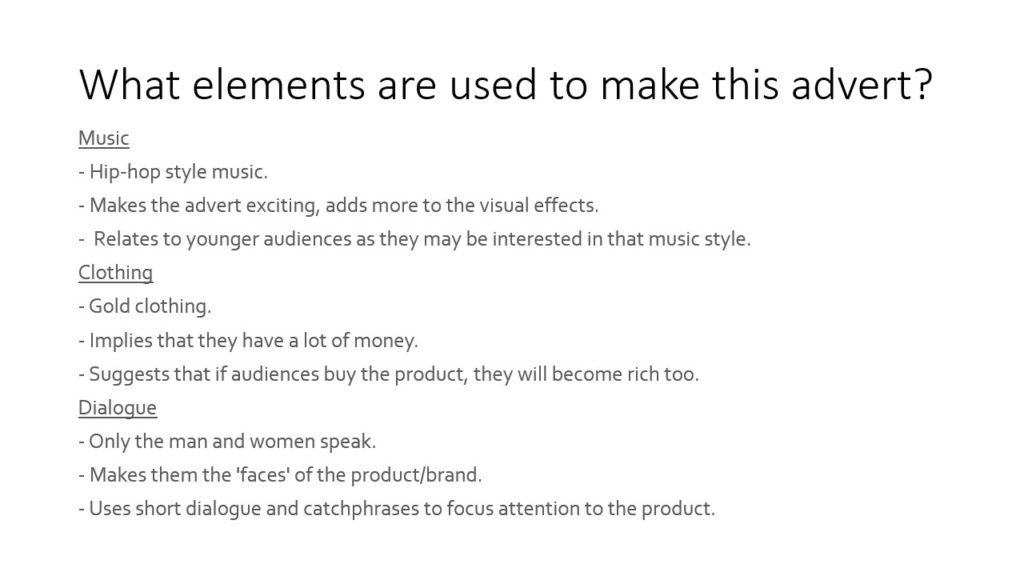| Technical Code | Denotation (ie what is it – simply describe what you see / hear) | Connotation (ie what does it signify what’s the meaning behind it) |
| Setting | a New York hotel room, 2 friends enter then open a suit case whole set changes and is ” bossed up” (glittered up and new sound affects/music is added) | as the bland room changes into a brand new room it shows the world transforms when the product is applied |
| Clothing | Neutral coloured clothing to start of with then after being bossed up clothes change to golden black and sparkle. | this shows again the transformation the product creates |
| NVC | The gestures and body language are done through out the video to show how amazing everything is | body language first displayed is exaggerated to show emotions of happiness and excitement then after they are bossed up they use stances that are considered powerful, strong and cool. To show the audience that it wasn’t just a physical change it was a mental change in confidence. |
| Dialogue | using unnatural conversations promoting the product then using slang for the slogan and for the advert. | convo used for promoting the product and using slang for the slogan then used for the advert suits easier for audiences to remember them. |
| Sound Effect | sound affects of subtle music beat under the characters voice, leading up to when they get bossed up the music increases and lots of sparkling and shinning sounds are used | the sound affects used are subtle music beat under the characters voice so the music is in the whole video and doesnt come in randomly in the video and as they get bossed up the music increases into a climax and lots of sparkling and shinning sounds used to emphasise the products desire by the viewer, explaining how the product is life changing. |
| Music | drum beat with dubstep leading the transformation of being “bossed up” | simple beat to get stuck in audiences heads so the advert becomes more rememberable because its easier to remember tunes over dialoge |
| Camera shot size | slow-motion skills are used plus different camera cuts for different angles and frames of time in seconds | this is done to make the product look more interesting and to show how life change the product is |
| Camera movement | slow horizontal smooth moving camera around the room plus the rise and fall after the suitcase is opened | this is done to make the product look more interesting and to show how life change the product is like its entering a new world when using the product |
| Editing | camera cuts are used quite a bit to jump from frames showing the product isn’t just bossing up the actors but bossing up the world(set) | this again shows us about the transformation the product supposedly creates |
Daily Archives: 11/06/2019
Filters
Comparison of the representation of Gender in Men’s Health and Tomb Raider
I Believe both pieces use gender to sexualise the product and to appeal to the heterosexual white middle class. Both media pieces select precise signs and combined them to make complex paradigms and syntagm and I will identify them and decode them to their most simple semiotic groups. Furthermore I will look at the context and reason for choices to represent gender in certain ways, adhering to and breaking the dominant ideology. Although they are different media forms they have many similarities in signs and in language but there are distinct differences making them identifiable as there own media forms. Finally I will address the impact not only of the obvious dominant ideology but also the historical, social and political contexts of media.
In Men’s Health they select black and blue on a white background, black and blue both being stereotypically male colours and add to this being a reactionary text, and use a semantic field of aggressive and destructive words, blast, demolish, slay and burn, which creates a paradigm of empowerment for the male reader. These two paradigms are the main way the magazine displays its intent of having a male audience, excluding the title of Men’s Health.This is furthered by the shining muscular man on the front cover. Through the plain grey shirt a shine from sweat and/or oil shows he has just finished working which focuses it appeal to the average middle aged middle to low class as they can relate and connect to the character. Through the use of the depiction of the stereotypical male it finishes off the representation males and the way males are marketed to.
The Tomb Raider cover has similarities to Men’s health as it is marketed towards males again but depicts a female on the front cover where she has perfect skin and make-up and sexualised body parts. This is a juxtaposition to the depiction of Vin diesel as she is the perfect ideal woman in the eyes of the dominant ideology and the majority of the male population. This is done to sexualise her and use her as a hook into the game, not because of the content or relatability but because of sexual attraction. The clear objectification is attempted to be covered by supposed empowerment by shoe horning a female into a male dominated role rather than creating a new role for a female. The empowerment is well achieved through the iconic signs of guns and adventure gear showing that she is brave and strong, this only creates a flimsy vale for a female recreation of similar male character, Indiana Jones, rather than a new engaging role or character. The sexualisation is furthered more subtly with the streaks of light highlighting both the breasts and rear creating an exaggerated curvy character.
Overall both pieces are set towards the stereotypical male audience
Media Essay on Gender
In this essay I intend to discuss the representation of gender through the dominant ideology of what the male and female bodies should look like. Men’s health is a magazine about how to be a healthy, muscular man. Tomb Raider is a coded video game about a young women who needs to overcome challenges to unlock new levels to play further into the game. I plan to argue my opinions with the help of a YouTube video by feminist frequency and another article by Lauren haul about body image.
Both of the materials negatively stereotype males and females. First of all we see this by the iconic sign of Vin Deiseal on the front cover of the Men’s Health magazine. He is portraying a strong muscular man giving the reader the message that if you want to be healthy and have good health you need to have large muscles and ‘blast body fat’ however this quote is both radical and reactionary as it is good to not have too much body fat and become obese but its radical as no man needs to have vast amounts of muscle to make them ‘slay’ and be desired by women. Likewise in Tomb Raider the iconic sign of Lara Croft shows a miss representation of what the female body should look like. The main image of Lara Croft is negatively stereotyped as she is viewed to have a tiny waist and large breast ‘Gard accidentally increased her breast size by 150 percent,’ this shows the male designer has the control on how he designs his character and when the game was first created Lara Croft was supposedly ament to have a positively stereotyped figure which would complement her positively stereotyped character however the ‘creative team insisted it was maintained.’ As this made the game more popular and they knew the game would sell better as it would attract more young male consumers who would be fantasied by this image and so intern want to play the game.
In both texts both images have extremely revealing clothes on, which suggests they both are the main focus of there texts and this is why you want to buy the game or magazine. Lara has tiny shorts and a little crop top and Vin Deiseal has an extremely tight top on to allow the audience to see his vast amounts of muscle and by them being able to see it the reader believes that they will be able to become like that if they buy this product. However this is a radical idea and thought as no one will be able to develop that amount of muscle from buying a magazine but that is what the company want you to believe. Both characters are standing in an unrealistic way which would clearly be uncomfortable so that the consumer can see more of their body features for example Vin Diesels arms bent outwards to show his large muscles and Lara Croft twisted round so that her bottom and breast are on display at the same time this is frustrating as a 2019 audience as we believe men and women are more than just their body image and that they have more to them then ‘big boobs or large, muscles.
In conclusion I believe both these texts are unsupportive of how the male and female body should be displayed and they both are representing negative stereotypes that make men and women believe they should be certain ways as the media is telling them to be this way as it will satisfy the opposite gender.
References
Lara Croft Article
Gender representation
In this essay I will show both the radical interpretation of women in the video game tomb raider and reactionary stereotype of men shown in the Men’s Health magazine. I will be exploring the issue of sexualisation used by Eidos in the character creation and gameplay of Tomb Raider, furthermore explaining how the game can be seen as radical. Additionally, I will explore the misrepresentation of men and the stereotype of being unfeeling and having to “blast body fat” or to have “t-shirt arms”.
In Men’s Health it uses Vin Diesel as an iconic sign, it’s that were all a meant to have muscles like him. This magazine cover makes out that it’s easy to lose weight “lose 8kg fast” and it expects all men to have lots of muscles “build a 6-pack for life”. This is a reactionary text and agrees with the stereotype that all men should be strong and emotionless as we can learn to “slay winter blues”. However, statistically suicide is more common with men and this could be partly due to fact men can be seen as weak by sharing their feelings.
Tomb Raider can be seen as radical as it has a female character holding a gun, this is a symbolic sign linked to violence. This is radical because it’s a counterstereotype, women are seen as caring or calm. It’s normally men that enjoy violence or pictured to be aggressive. An iconic sign on the game cover is Lara and how she’s a meant to be attractive and skinny, this is reactionary as stereotypical women are pretty and skinny. On the cover she is also wearing short shorts and a crop top, this is used to sexualise and objectify her to make the game cover more appealing to men which is the games target audience.
The audience for the Men’s Health magazine are men who want to lose weight or feel like they need to exercise or workout to look like a stereotypical man accepted by society. The uses and gratification theory developed by Bulmer and Katz states that users seek out media sources which best fulfils their needs and assumes people choose certain media for five different reasons, these are: Information and education, entertainment, personal identity integration and social interaction and escapism. Men’s Health could fall into both Information and personal identity as readers may want to learn how to lose weight or to be inspired by others.
However, Tomb Raider falls into the entertainment section for both its sexualisation of Lara to increase the games attraction for men/ target audience and for its gameplay.
In conclusion, both covers are reactionary as they give society an unrealistic representation of how men and women should look. In Tomb Raider, Lara is extremely sexualised and used as a way to create appeal for the game this can make people set goals to look like something can’t be. Men’s Health also causes men to set extreme targets of how they want to look and can cause low esteem of people who can’t reach these targets. Both CSPs are negative stereotypes and cause fake dominant ideologies giving people bad constructed realities of themselves.
Question 1 and 2
csp 3 – maybelline advert analysis



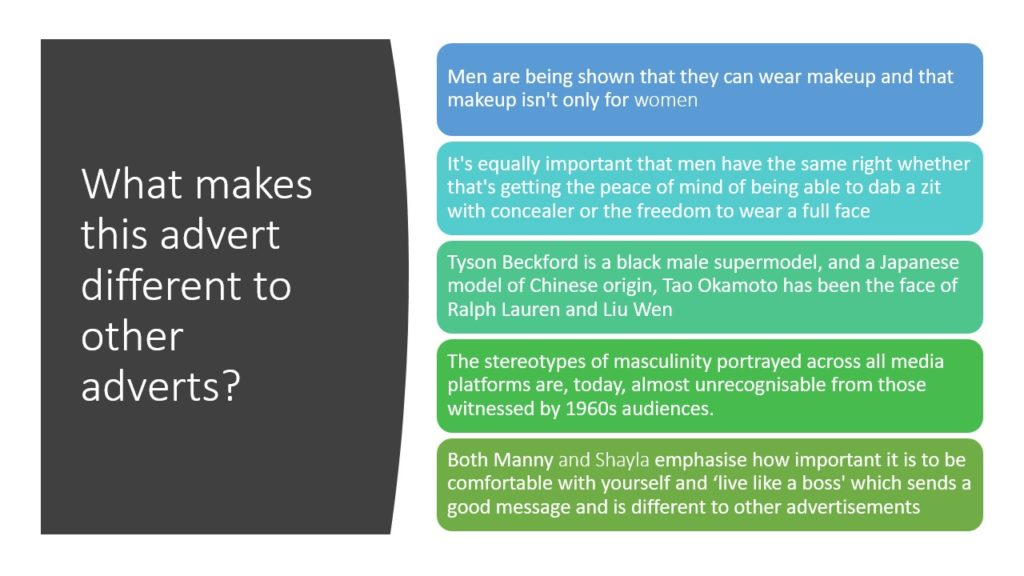

MAYBELLINE ANALYSIS
powerpoint



